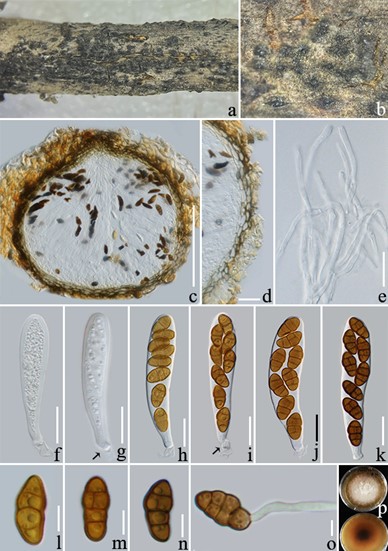Deniquelata yunnanensis L. Lu, K.D. Hyde & Tibpromma, sp. nov. (Figure 5)
MycoBank number: MB; Index Fungorum number: IF; Facesoffungi number: FoF 12763;
Etymology: Name reflects the location Yunnan Province, where the holotype was collected.
Holotype: ZHKU 22-0115
Saprobic on decaying branch of Coffea sp. Sexual morph: Ascomata 140–240 μm high, 170–240 μm diam (x̅ = 187 × 209 μm, n = 20), semi-immersed, aggregated to solitary, globose to subglobose, dark brown to black, with ostiole and apex papillate to depressed. Peridium 12−17 µm wide (x̅ = 14, n = 15), composed of two walls, outer wall light brown to brown, comprising 2–3 layers, cells of textura angularis, fused with the host cells, inner wall thin, hyaline cell. Hamathecium composed of dense, 1.5−3 µm wide (x̅ = 2, n = 20), branched, hyaline, septate pseudoparaphyses, surrounding the numerous asci and enclosed in a gelatinous matrix. Asci 50–85 × 10–17 μm (x̅ = 68 × 13 μm, n = 30), 8-spored, bitunicate, fissitunicate, clavate, with a short furcate pedicel. Ascospores 11–16 × 4–8 μm (x̅ = 14 × 6.6 μm, n = 30), 2-seriated ascospores, partially overlapping, muriform, hyaline when young, yellow to brown at maturity and with distinct guttulate, ellipsoidal to oblong, with 0–2 longitudinal septate in each cell, 1–3 transverse septate, constricted at the septa, slightly curved to straight, apically conical to elliptical, without sheath. Asexual morph: Not observed.
Culture characteristics: Ascospores germinated within 12 h on PDA, growing on PDA reaching around 40 mm after one month at room temperature (25 °C). Surface white to light grey, circular, cottony and fluffy, slightly raised in the middle, margin filamentous, reverse yellowish to light brown.
Material examined: China, Yunnan Province, Xishuangbanna, on decaying branch of Coffea sp., (1672 m), 12 September 2021, LiLu, JHMH 10 (ZHKU 22-0115, holotype), ZHKUCC 22-0198 = ZHKUCC 22-0199. GenBank number; ITS: ***, LSU: ***, SSU: ***, tef1-α: ***, rpb2: *** (ZHKUCC 22-0198, ex-type); ITS: ***, LSU: ***, SSU: ***, tef1-α: ***, rpb2: *** (ZHKUCC 22-0199).
Notes: In the phylogenetic analyses, Deniquelata yunnanensis formed a distinct clade sister to Deniquelata with strong statistical support (100 ML/1.00 BYPP, Figure 1). In the NCBI blast results of sequences, ITS 92.8% similar to D. barringtoniae (MH141242), LSU/tef1-α/rpb2 similar to D. hypolithi (NG_076735, 97.8%), (MZ078250, 97%) and (MZ078201, 94%) respectively, while SSU highly overlapped with Deniquelata sp. (MH316155) at 99%. Morphologically, our strains well fit with the generic characteristics of Deniquelata [53,54]. Asexual morph of D. hypolithi was reported [55], while the sexual morph D. yunnanensis can be distinguished from D. barringtoniae by the color of ascospores yellow to brown at maturity and with distinct guttulate, and 1–3 transverse septa, 0–2 longitudinal septa in each ascospore, while ascospores in D. barringtoniae are reddish-brown, with three transverse septa and 1−2 vertical septa in each ascospore [53]. Both the phylogenetic analyses and morphological characteristics supported our species as a distinct new species in Deniquelata.

Figure 5. Deniquelata yunnanensis (ZHKU 22-0115). (a,b) Ascomata on a decaying branch of Coffea sp.; (c) Vertical section of an ascoma; (d) Peridium; (e) Pseudoparaphyses; (f–k) Asci, arrows indicate short furcate pedicel; (l–n) Ascospores; (o) Germinated ascospore; (p) Colonies on PDA. Scale bars: (c) = 100 µm; (d–k) = 15 µm; (l–o) = 5 µm.
